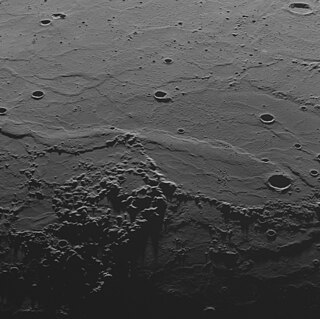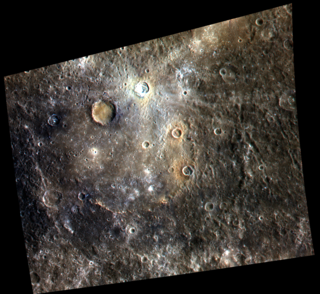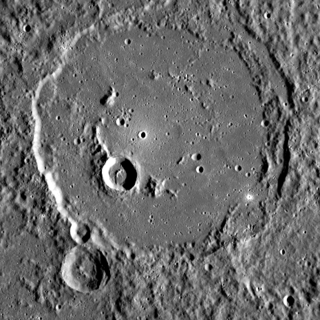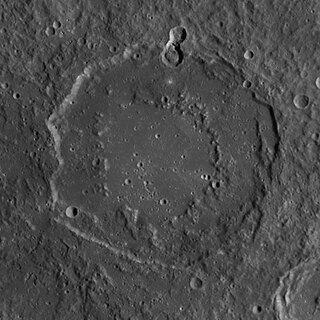
Degas is a rayed crater on Mercury at latitude 37.5 N, longitude 127 W. Its diameter is 54 kilometres (34 mi). It was named after the French impressionist painter Edgar Degas in 1979. The rays consist of light colored material blasted out during the crater's formation. Craters older than Degas are covered by the ray material, while younger craters are seen superimposed on the rays. Degas forms a crater pair with Brontë to the north. Both lie near the center of Sobkou Planitia.

Odin Planitia is a large basin on Mercury. It was named after the Norse god Odin, who was sometimes considered to be the equivalent of the Roman god Mercury, in 1976 by the IAU. It was first observed in detail by Mariner 10. The plain is approximately 473 kilometers in diameter.

Tir Planitia is a large plain on the planet Mercury. The name Tir (تیر) is the Persian word for "Mercury", and the name was approved in 1976. It was first observed in detail by Mariner 10. It lies between the large crater Mozart and the ancient Tolstoj basin.

Bach is a double-ringed impact basin within the Bach quadrangle of Mercury. It was named by the IAU in 1976.

Michelangelo is a 230 km diameter impact basin in the Michelangelo quadrangle of Mercury, which is named after this crater. The crater itself was named by the IAU in 1979 after the Italian painter, sculptor and architect Michelangelo.

Mozart is a crater on Mercury, named by the IAU in 1976 after Austrian composer Wolfgang Amadeus Mozart.

Homer is a crater on Mercury. It is one of 110 peak ring basins on Mercury. It is Tolstojan in age.

Polygnotus is a crater on Mercury, named by the IAU in 1976, after ancient Greek painter Polygnotus. The crater was first imaged by Mariner 10 in 1974.

Scarlatti is a pit-floored crater on Mercury, which was discovered in 1974 by the Mariner 10 spacecraft. It has a prominent peak ring, and it is one of 110 peak ring basins on Mercury. The crater floor is covered by the smooth plains material. The crater displays an arcuate collapse feature along the northeastern peak ring. The size of the pit, which was first noticed in MESSENGER images obtained in January 2008, is 38 × 12 km. Such a feature may have resulted from collapse of a magma chamber underlying the central peak ring complex of the crater. The collapse feature is an analog of Earth's volcanic calderas. Scarlatti is thought to have the same age as the Caloris basin.

Derain is a crater on Mercury named after André Derain, a French artist, painter, sculptor and co-founder of Fauvism with Henri Matisse. It has uncommonly dark material within and surrounding the crater. The material is darker than the neighboring terrain such that this crater is easily identified even in a distant global image of Mercury. The dark halo may be material with a mineralogical composition different from the majority of Mercury's visible surface. Craters with similar dark material on or near their rims were seen on the floor of the Caloris basin during MESSENGER’s first flyby.

Kālidāsā is a crater on Mercury. Its name was adopted by the International Astronomical Union in 1976. Kalidasa is named for the Indian writer Kālidāsa, who lived in the 5th century CE.

Strindberg is a 189 km diameter impact basin in the Shakespeare quadrangle of Mercury. It was named after the Swedish playwright, novelist and short story writer August Strindberg.

Sanai is a large, ancient crater on Mercury. Its name was adopted by the International Astronomical Union in 2014, after the Persian poet, Sanai of Ghazna.

Alver is a crater on Mercury. It has a diameter of 151.49 kilometers. Its name was adopted by the International Astronomical Union (IAU) on March 15, 2013. Alver is named for the Estonian poet Betti Alver.

Nabokov is a crater on Mercury. Its name was adopted by the International Astronomical Union (IAU) on April 24, 2012. Nabokov is named for the Russian and American author Vladimir Nabokov.

Faulkner is a crater on Mercury. It has a diameter of 168 kilometres. Its name was adopted by the International Astronomical Union (IAU) on April 24, 2012. Faulkner is named for the American author William Faulkner.

Catullus is a crater on Mercury. Its name was adopted by the International Astronomical Union (IAU) on December 19, 2012. Catullus is named for the Roman poet Catullus.

Mearcair Planitia is a large plain on the planet Mercury. The name Mearcair is the Irish and Scottish Gaelic word for "Mercury", and the name was approved in 2017. It was first observed in detail by MESSENGER. It lies between the large crater Raditladi and the ancient Caloris basin.

Stilbon Planitia is a large plain on the planet Mercury. The name Stilbon is ancient Greek word for "Mercury", and the name was approved in 2017. It was first observed in detail by MESSENGER. It lies north of the Caloris basin, and is approximately 1550 kilometers long.
Otaared Planitia is a smooth plain on Mercury. It was named for the Arabic word for the planet Mercury, in 2017 by the IAU. The plain is approximately 470 km (290 mi) in diameter.






















